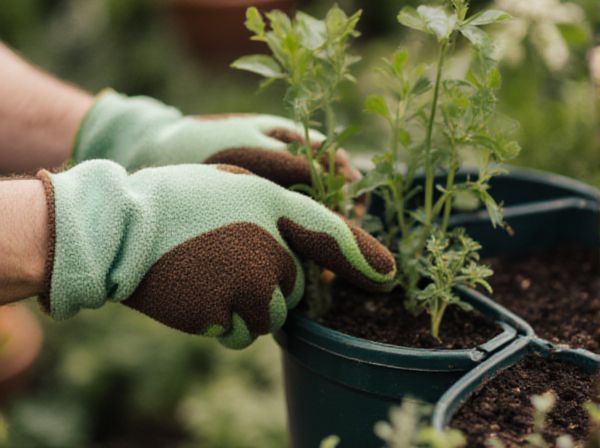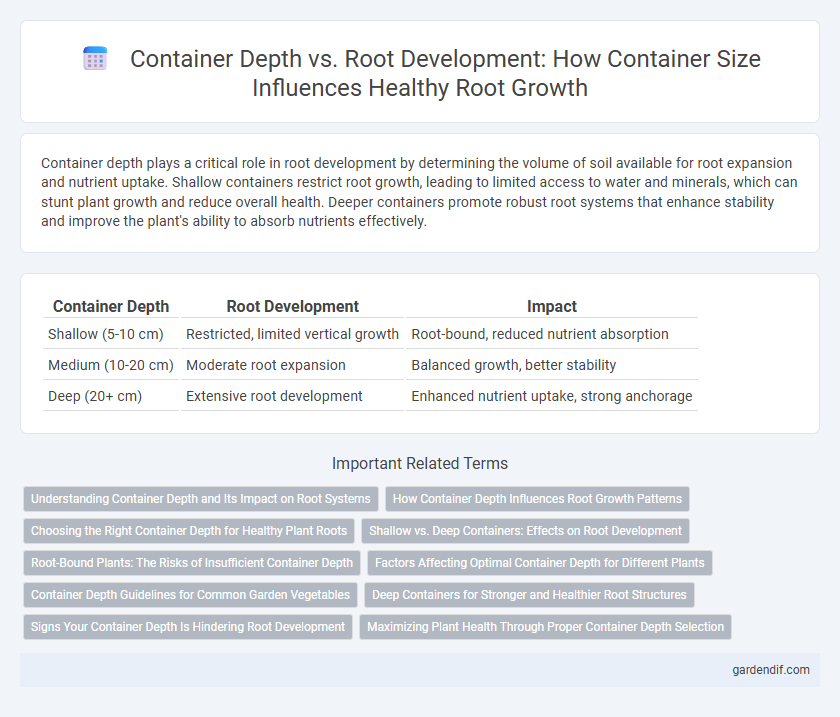
Container depth vs root development Illustration
Container depth plays a critical role in root development by determining the volume of soil available for root expansion and nutrient uptake. Shallow containers restrict root growth, leading to limited access to water and minerals, which can stunt plant growth and reduce overall health. Deeper containers promote robust root systems that enhance stability and improve the plant's ability to absorb nutrients effectively.
Table of Comparison
| Container Depth | Root Development | Impact |
|---|---|---|
| Shallow (5-10 cm) | Restricted, limited vertical growth | Root-bound, reduced nutrient absorption |
| Medium (10-20 cm) | Moderate root expansion | Balanced growth, better stability |
| Deep (20+ cm) | Extensive root development | Enhanced nutrient uptake, strong anchorage |
Understanding Container Depth and Its Impact on Root Systems
Container depth directly influences root development by determining the space available for root expansion and nutrient absorption. Shallow containers can restrict root growth, leading to stunted plants and poor water retention, while deeper containers promote robust root systems, enhancing stability and overall plant health. Selecting an appropriate container depth based on the specific plant species ensures optimal root architecture and maximizes growth potential.
How Container Depth Influences Root Growth Patterns
Container depth significantly impacts root development by determining the volume of soil available for roots to expand vertically. Shallow containers restrict deep root growth, often causing roots to become cramped and leading to limited nutrient uptake. Conversely, deeper containers encourage robust root systems, promoting healthier plant growth and stability.
Choosing the Right Container Depth for Healthy Plant Roots
Selecting the appropriate container depth is crucial for robust root development as deeper containers allow roots to grow downward and spread naturally, preventing root circling and stunting. Shallow containers restrict root expansion and often cause roots to become root-bound, leading to poor nutrient absorption and compromised plant health. Optimal container depth varies by plant species but generally should be at least as deep as the root ball plus several inches to accommodate healthy growth and airflow.
Shallow vs. Deep Containers: Effects on Root Development
Shallow containers restrict root growth by limiting soil volume and oxygen availability, often leading to root crowding and impaired nutrient uptake. Deep containers promote extensive root development by providing ample space for root elongation and better aeration, resulting in healthier, more robust plants. Root architecture in deep containers supports improved water retention and enhanced access to nutrients compared to shallow containers.
Root-Bound Plants: The Risks of Insufficient Container Depth
Insufficient container depth restricts root growth, causing plants to become root-bound, which limits nutrient uptake and reduces overall health. Shallow containers force roots to circle and entangle, leading to stress, stunted growth, and increased susceptibility to disease. Adequate container depth is essential to support robust root systems, ensuring optimal development and improved plant vitality.
Factors Affecting Optimal Container Depth for Different Plants
Container depth significantly influences root development by determining the available space for root expansion, oxygen access, and water retention. Shallow containers restrict root growth, impacting nutrient uptake and overall plant health, while deep containers accommodate plants with extensive root systems, such as tomatoes or perennials. Soil type, plant species, and watering frequency are critical factors to consider when selecting optimal container depth to ensure adequate root aeration and robust plant growth.
Container Depth Guidelines for Common Garden Vegetables
Container depth directly influences root development in common garden vegetables, as shallow containers can restrict root growth, leading to poor nutrient uptake and stunted plants. For example, tomatoes and peppers require containers at least 12-18 inches deep to support their extensive root systems, while leafy greens like lettuce can thrive in 6-8 inch deep containers due to their shallow roots. Ensuring appropriate container depth optimizes plant health, improves water retention, and enhances overall yield in container gardening.
Deep Containers for Stronger and Healthier Root Structures
Deep containers promote extensive root development by allowing roots to grow downward naturally, preventing root circling and enhancing nutrient absorption. Stronger and healthier root structures develop in deep containers because they offer ample space for roots to expand and access oxygen more effectively. This improved root environment supports vigorous plant growth and increased resilience against environmental stress.
Signs Your Container Depth Is Hindering Root Development
Shallow container depth restricts root expansion, causing roots to become pot-bound and stunted, visibly resulting in poor plant growth and wilting despite adequate watering. Signs include roots circling the container's edge, reduced nutrient uptake, and yellowing leaves indicating stress. Ensuring sufficient container depth allows roots to develop properly, promoting healthier and more vigorous plant growth.
Maximizing Plant Health Through Proper Container Depth Selection
Proper container depth directly influences root development, providing adequate space for roots to expand and access essential nutrients and water. Shallow containers restrict root growth, leading to stunted plants and reduced overall health, while deeper containers promote robust root systems that enhance stability and nutrient uptake. Selecting the right container depth tailored to specific plant species maximizes plant health by supporting optimal root architecture and preventing root-bound conditions.
Container depth vs root development Infographic

 gardendif.com
gardendif.com